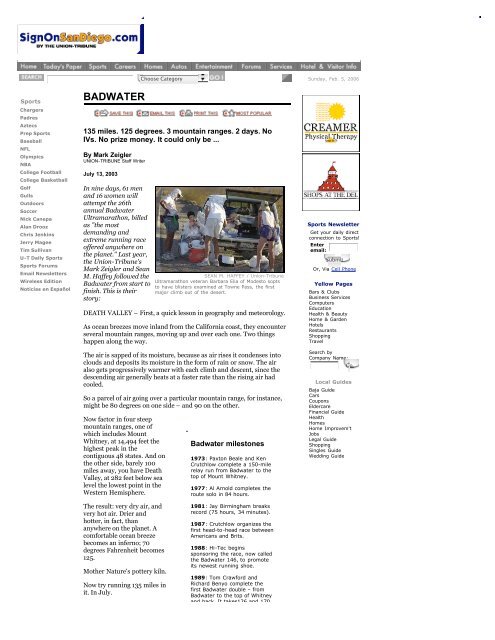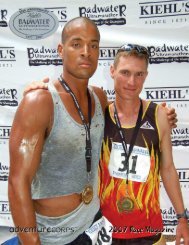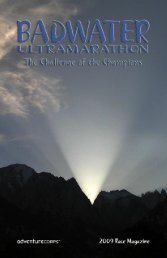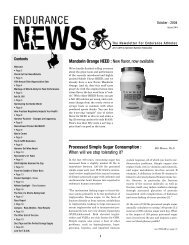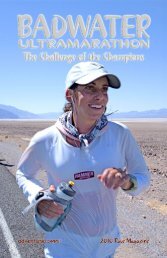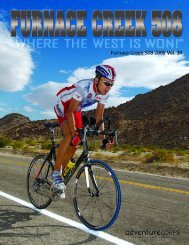BADWATER - AdventureCORPS
BADWATER - AdventureCORPS
BADWATER - AdventureCORPS
Create successful ePaper yourself
Turn your PDF publications into a flip-book with our unique Google optimized e-Paper software.
Choose Category Sunday, Feb. 5, 2006<br />
Sports<br />
Chargers<br />
Padres<br />
Aztecs<br />
Prep Sports<br />
Baseball<br />
NFL<br />
Olympics<br />
NBA<br />
College Football<br />
College Basketball<br />
Golf<br />
Gulls<br />
Outdoors<br />
Soccer<br />
Nick Canepa<br />
Alan Drooz<br />
Chris Jenkins<br />
Jerry Magee<br />
Tim Sullivan<br />
U-T Daily Sports<br />
Sports Forums<br />
Email Newsletters<br />
Wireless Edition<br />
Noticias en Español<br />
<strong>BADWATER</strong><br />
135 miles. 125 degrees. 3 mountain ranges. 2 days. No<br />
IVs. No prize money. It could only be ...<br />
By Mark Zeigler<br />
UNION-TRIBUNE Staff Writer<br />
July 13, 2003<br />
In nine days, 61 men<br />
and 16 women will<br />
attempt the 26th<br />
annual Badwater<br />
Ultramarathon, billed<br />
as "the most<br />
demanding and<br />
extreme running race<br />
offered anywhere on<br />
the planet." Last year,<br />
the Union-Tribune's<br />
Mark Zeigler and Sean<br />
M. Haffey followed the<br />
Badwater from start to<br />
finish. This is their<br />
story:<br />
SEAN M. HAFFEY / Union-Tribune<br />
Ultramarathon veteran Barbara Elia of Modesto sopts<br />
to have blisters examined at Towne Pass, the first<br />
major climb out of the desert.<br />
DEATH VALLEY – First, a quick lesson in geography and meteorology.<br />
As ocean breezes move inland from the California coast, they encounter<br />
several mountain ranges, moving up and over each one. Two things<br />
happen along the way.<br />
The air is sapped of its moisture, because as air rises it condenses into<br />
clouds and deposits its moisture in the form of rain or snow. The air<br />
also gets progressively warmer with each climb and descent, since the<br />
descending air generally heats at a faster rate than the rising air had<br />
cooled.<br />
So a parcel of air going over a particular mountain range, for instance,<br />
might be 80 degrees on one side – and 90 on the other.<br />
Now factor in four steep<br />
mountain ranges, one of<br />
which includes Mount<br />
Whitney, at 14,494 feet the<br />
highest peak in the<br />
contiguous 48 states. And on<br />
the other side, barely 100<br />
miles away, you have Death<br />
Valley, at 282 feet below sea<br />
level the lowest point in the<br />
Western Hemisphere.<br />
Badwater milestones<br />
1973: Paxton Beale and Ken<br />
Crutchlow complete a 150-mile<br />
relay run from Badwater to the<br />
top of Mount Whitney.<br />
1977: Al Arnold completes the<br />
route solo in 84 hours.<br />
Sports Newsletter<br />
Get your daily direct<br />
connection to Sports!<br />
Enter<br />
email:<br />
Submit<br />
Or, Via Cell Phone<br />
Yellow Pages<br />
Bars & Clubs<br />
Business Services<br />
Computers<br />
Education<br />
Health & Beauty<br />
Home & Garden<br />
Hotels<br />
Restaurants<br />
Shopping<br />
Travel<br />
Search by<br />
Company Name:<br />
Go<br />
Local Guides<br />
Baja Guide<br />
Cars<br />
Coupons<br />
Eldercare<br />
Financial Guide<br />
Health<br />
Homes<br />
Home Improvem't<br />
Jobs<br />
Legal Guide<br />
Shopping<br />
Singles Guide<br />
Wedding Guide<br />
The result: very dry air, and<br />
very hot air. Drier and<br />
hotter, in fact, than<br />
anywhere on the planet. A<br />
comfortable ocean breeze<br />
becomes an inferno; 70<br />
degrees Fahrenheit becomes<br />
125.<br />
Mother Nature's pottery kiln.<br />
Now try running 135 miles in<br />
it. In July.<br />
1981: Jay Birmingham breaks<br />
record (75 hours, 34 minutes).<br />
1987: Crutchlow organizes the<br />
first head-to-head race between<br />
Americans and Brits.<br />
1988: Hi-Tec begins<br />
sponsoring the race, now called<br />
the Badwater 146, to promote<br />
its newest running shoe.<br />
1989: Tom Crawford and<br />
Richard Benyo complete the<br />
first Badwater double – from<br />
Badwater to the top of Whitney<br />
and back. It takes126 and 170
9:45 a.m., Badwater, 100<br />
degrees.<br />
If the geography isn't<br />
forbidding and foreboding<br />
enough, there are the names.<br />
Dante's View. Coffin Peak.<br />
Funeral Mountains. Devil's<br />
Golf Course. Desolation<br />
Wash. Dead Man Pass. Hell's<br />
Gate. Death Valley.<br />
Badwater is aptly named as<br />
well. There is water here,<br />
and it is bad – a toxic, putrid<br />
stew of alkalis that would kill<br />
you if you drank enough of it.<br />
and back. It takes126 and 170<br />
hours, respectively.<br />
1996: The time required to<br />
earn a Badwater belt buckle is<br />
raised from 45 to 48 hours.<br />
2000: Anatoli Kruglikov of<br />
Russia sets the 135-mile course<br />
record of 25:09:05.<br />
2002: Pam Reed lowers the<br />
women's record to 27:56:47.<br />
2003 Badwater<br />
Ultarmarathon<br />
When: July 22-24<br />
Who: 61 men, 16 women from<br />
around the world<br />
Live Webcast:<br />
www.badwaterultra.com.<br />
It is here that the Badwater<br />
135 road race begins, next to<br />
a smelly pond and a wooden<br />
sign that says you are 280<br />
feet below sea level. The<br />
tradition is for the competitors to pose around the wooden sign, then<br />
walk 50 yards to the road and begin their 135-mile odyssey through the<br />
desert, over two mountain passes, across an endless valley and finally –<br />
one, two, sometimes three days later – halfway up Mount Whitney.<br />
Assuming you get that far.<br />
Racers face temperature<br />
changes of up to 90<br />
degrees, and 13,000 feet<br />
in cumulative altitude<br />
gains and 4,700 feet in<br />
knee-crunching<br />
descents. There are<br />
sidewinder rattlesnakes<br />
just off the road,<br />
coyotes, scorpions,<br />
tarantulas and<br />
mountains lions. One<br />
year a racer was buzzed<br />
by a rabid bat. Another<br />
year a family of bears<br />
was spotted near the<br />
finish line at Whitney<br />
Portal.<br />
SEAN M. HAFFEY / Union-Tribune<br />
135 miles. 125 degrees. 3 mountain ranges. 2 days.<br />
No IVs. No prize money. It could only be ...<br />
Badwater. Above, blurred by the heat radiating off<br />
the pavement, Ian Parker, a Badwater rookie from<br />
Irvine, learns firsthand the toll Death Valley exacts.<br />
In the Owens Valley, fighter jets from Edwards Air Force Base appear<br />
out of nowhere and make strafing runs at perilously low heights, which<br />
causes all sorts of psychological havoc on physically exhausted, sleepdeprived,<br />
severely dehydrated runners prone to vivid hallucinations.<br />
There is also the swirling wind, and the occasional sand storm or<br />
lightning strike. In this race, two fires on the other side of the Sierra<br />
send their choking smoke into racers' lungs.<br />
But mostly there is the raw heat. Relentless. Merciless. Endless. It<br />
drains your body of precious water. It fries your mind's motherboard<br />
and shuts down its circuitry. It evaporates your inner will, one drop of<br />
sweat at a time.<br />
Rubber soles melt. Air heel cushions burst. Raw skin bubbles. One<br />
competitor talks wistfully about the record-setting heat in 1998, when<br />
air temperatures reached 130 and "my toenails exploded like kernels of<br />
popcorn." Most racers bring seven, eight, nine pairs of running shoes in<br />
progressively larger sizes because their feet swell so much.<br />
Did we mention that IVs are prohibited during the race and there are<br />
no official aid stations?<br />
"If you had aid stations," race director Chris Kostman says, "first of all<br />
the people in the aid stations would die."<br />
The 80 competitors are divided into three flights, with 6, 8 and 10 a.m.<br />
starts. The 10 a.m. group gathers around the wooden sign and looks<br />
back at Kostman and his camera.<br />
"We've already had our first 911 call," Kostman tells the competitors in
a monotone as dry as the air around them. "Let's hope it's our only one<br />
today. Someone has already passed out a couple of times. On that note,<br />
welcome to the 25th Badwater 135.<br />
"Smile, guys."<br />
His name is Derek McCarrick. He is from Isle of Sheppey, England.<br />
He is a 67-year-old coal miner-turned-taxi driver, and he runs<br />
marathons and other ultradistance events as a hobby. He raises money<br />
for charities, mostly for breast cancer (which claimed his wife) and<br />
leukemia (which claimed a friend's daughter).<br />
His schtick is that he wears a rabbit suit, with furry pants and a furry<br />
top and a furry rabbit head with floppy ears. He's run the London<br />
Marathon 21 times and is known simply as "Roger Rabbit" to fans and<br />
race organizers. Kids lining the course love him.<br />
In the months before the 2002 Badwater, Kostman receives<br />
McCarrick's entry application. Kostman calls him and explains that he<br />
meets all the necessary qualifications, but "you can't possibly wear that<br />
rabbit outfit here."<br />
No problem, McCarrick tells Kostman. He has a special desert suit. He<br />
wore it in the Marathon des Sables, a six-day, 151-mile event across the<br />
Sahara in April.<br />
"So I sort of pictured a (baseball) hat with small bunny ears on it and a<br />
bunny silk-screened on his shirt, shorts and running shoes," Kostman<br />
says.<br />
McCarrick shows up for his 6 a.m. start with long, furry pants, floppy<br />
rabbit feet over his shoes and a giant green bow. That is his first<br />
mistake. His second: Drinking only 1-1/2 liters of water over the first<br />
nine miles, when most medical experts recommend a liter per mile.<br />
Three hours into the race, McCarrick is slumped in the passenger seat<br />
of his crew's minivan, comatose. When his condition does not improve<br />
markedly over the next several hours, he withdraws to avoid becoming<br />
the first person in race history to die.<br />
Kostman shakes his head. Another year, another victim.<br />
"This race is just so far beyond any other running event that it's just in<br />
a league of its own," says Kostman, whose adventureCORPS company<br />
organizes several other endurance events. "Most of the top 100-mile<br />
runners won't do this race because they're scared. They're afraid they'll<br />
discover they're out of their element, afraid to discover they won't be<br />
competitive.<br />
"One-hundred-mile racers, their paradigm is that what they do is the<br />
toughest thing. They're like an ostrich with their head stuck in the<br />
sand, because what they do is not the toughest thing. This is."<br />
Ann Trason is considered the queen of ultrarunning, having won the<br />
women's division of the grueling Western States 100 a record 14 times.<br />
She tried Badwater once – as part of someone's support crew that<br />
follows a racer in a minivan. She wants no part of racing it.<br />
"It's more of a hike, a 130-degree-in-a-sandstorm hike, a torture-fest<br />
that I don't want to repeat," Trason told Ultrarunning magazine. "I like<br />
adventure, but this is an out-of-this-world experience. I drank more<br />
crewing Badwater than I did running Western States.<br />
"I felt like I was in 'Star Trek' – and I wanted to be beamed out."<br />
The carnage is not reserved for 67-year-old Isle of Sheppey cabbies in<br />
furry bunny suits. (Or for a Japanese doctor who is studying the effects<br />
of heat on runners and passes out herself, despite spending most of the<br />
day in an air-conditioned car.)<br />
The leader for the first 50 miles, John Quinn, had painstakingly<br />
developed calluses on his feet so blisters wouldn't end his race as they<br />
had in the past. Instead he develops blisters underneath his calluses on<br />
the way up 4,965-foot Towne Pass, can't drain them with a hypodermic<br />
needle and withdraws.<br />
There is Germany's Achim Heukemes. Six weeks earlier he had run<br />
1,000 miles over 11 days through the streets of Hamburg, stopping for<br />
2-1/2 hours each night to sleep. In 2001 he covered 234 miles in a 48-<br />
hour event in a French stadium, which was eight miles short of the
ecord he set two years earlier. He shows up in Death Valley and tells<br />
people two things, that he's going to run the entire 135 miles without<br />
stopping and that he's going to win.<br />
He doesn't make it to the 72-mile checkpoint, either. His body shuts<br />
down and refuses to digest food.<br />
"You feel good, good, good, and then you break down," Heukemes says.<br />
"Usually you rest an hour and you come back. But here, you don't<br />
come back."<br />
Or there is Brazil's Manoel de Jesus Mendes, another of the prerace<br />
favorites who says on his entry form that "being able to surpass the<br />
limits of my body and mind has become my main objective in life." At<br />
midnight the first day, he is lying in a fetal position on the side of the<br />
road, sobbing.<br />
Assesses the race's medic: "He just emotionally grenaded."<br />
The 10 a.m. flight of runners stands at the start and listens to the<br />
national anthem played from a car stereo. Someone in the back of a<br />
pickup truck holds aloft an American flag, which hangs limp in the<br />
already suffocating heat.<br />
There is no starter's pistol. There is a 10-second countdown and a tall,<br />
aging man says: "Bang."<br />
The man is 75-year-old Al Arnold, the godfather of Badwater. "I see<br />
more cars in the parking lot right now than I did during the entire race<br />
in 1977," he says, "and that's counting through traffic along the roads. I<br />
had no clue this thing would ever take off."<br />
Arnold uses the term "race" loosely. Back then, the Badwater was less a<br />
competition than a challenge – less an organized test of endurance<br />
than a barroom dare.<br />
In 1973 Arnold heard about two men completing a 150-mile relay run<br />
from Badwater to the top of Mount Whitney in the dead of summer.<br />
Being something of an adventure junkie himself, Arnold persuaded<br />
buddy David Gabor to do it with him in 1974 – only not as a relay.<br />
Gabor lasted 5-1/2 miles.<br />
"It hit him like a ton of bricks," Arnold says. "His entire nervous<br />
system shut down and he went into shock. He almost died. They took<br />
him to the Furnace Creek Ranch (hotel) and filled a bathtub with ice<br />
and stuck him in it for 10 hours. He was very sick for about a year after<br />
that."<br />
Worried about the welfare of his friend, Arnold quit a few hours later.<br />
He tried again the following year, preparing for the desert ferocity by<br />
riding a stationary bike in a 165-degree sauna, but his knee went out<br />
on Towne Pass and he quit again.<br />
In 1977 Arnold returned in even better shape. This time, he cranked up<br />
the sauna to 200 degrees and made daily runs up Mount Diablo near<br />
his home in the San Francisco Bay Area.<br />
Eighty-four hours after leaving Badwater, he was standing on top of<br />
Whitney. He had lost 17 pounds.<br />
He never did it again, but he didn't need to. He had created a monster.<br />
For the next decade, the Badwater was a solo "race" against the clock.<br />
The first head-to-head competition was in 1987 and it was called the<br />
Badwater 146, the extra 11 miles being the distance between Whitney<br />
Portal and the peak.<br />
In 1989, the U.S. Forest Service forced the race to end at Whitney<br />
Portal, elevation 8,360 feet – something about not holding athletic<br />
competitions in designated wilderness areas. Each year a few nostalgic<br />
competitors will obtain their own hiking permits and complete the old<br />
route; most, however, figure they've made their point when they cross<br />
the finish line adjacent to the Whitney trailhead.<br />
And exactly what is that point?<br />
It's a simple question, and a complex one. Why?<br />
There is no prize money in the Badwater. There is no live TV and there
is minimal newspaper coverage. You get a T-shirt for entering and a<br />
belt buckle if you finish under 48 hours.<br />
You are required to sign a medical waiver that begins: I acknowledge<br />
that this athletic event is an extreme test of a person's physical and<br />
mental limits and carries with it the potential for death.<br />
You pay $250 in entry fees (plus $2,000 or $3,000 in crewing<br />
expenses) for the privilege of running through a desert in late July and<br />
halfway up the Lower 48's highest peak. Most people take vacation<br />
from stable jobs to do it.<br />
"You say Badwater and no one has ever heard of it," says Kostman, the<br />
race director. "They're not doing it to bring recognition from the public<br />
at large, because the public at large doesn't know about it. And if you<br />
try to explain it to people, they can't fathom it. People do this for their<br />
own personal reasons."<br />
There are cancer survivors here, intent on taking their invincibility a<br />
step further. There are recovering alcoholics. There are political<br />
refugees from oppressive foreign regimes. There are people who do it<br />
because, as one man says, "equipment, status and personal wealth have<br />
little do with one's success in this sport." There are people who do it<br />
because, as a Badwater veteran puts it, "I'm good at it."<br />
There are people who started running 10ks, then graduated to<br />
marathons, then graduated to ultramarathons, then find themselves<br />
standing beside a smelly pond and a wooden sign in the depths of<br />
Death Valley in late July.<br />
"Maybe there's some masochistic element in your makeup that makes<br />
you want to do it," says Ben Jones, a physician in nearby Lone Pine<br />
and the so-called mayor of Badwater. "It's like why did Norgay and<br />
Hillary climb Everest – because it was there. I think people do this to<br />
see if they can get away with it."<br />
Ten minutes before the 10 a.m. start, 53-year-old Steven Silver of El<br />
Paso, Texas, walks up to Arnold and shakes his hand.<br />
"I've done this five times, Al, and I want to thank you," Silver says.<br />
"I could have been sitting in my office right now, getting ready to eat<br />
lunch, with a beautiful secretary. Instead I'm out here.<br />
"Thank you."<br />
5 p.m., Stovepipe Wells, 125 degrees.<br />
Reg Richard is lying in the pool at the Stovepipe Wells Village, a motel<br />
at mile 42 that sits at the base of the race's first major climb. The pool<br />
water is close to 90 degrees. Richard is shivering uncontrollably.<br />
Richard's fiancee, Mary Berry, met him at a hospital in Dayton, Ohio,<br />
where she's a nurse and he's a physical therapist. Being medically<br />
proficient (and conscientious), Berry has been meticulously charting<br />
her 51-year-old fiance's progress through the desert.<br />
Every 20 minutes she gives him a new plastic bottle with 20 ounces of<br />
fluid and records how much is left in the old one. She also conducts a<br />
periodic roadside urinalysis, using a test strip to measure his levels of<br />
glucose, bilirubin, urobilirubin, ketone, specific gravity, blood, pH<br />
protein, nitrate and leukocytes.<br />
The charts are clear. Richard is crashing.<br />
For the first few hours after his 8 a.m. start, he returns every water<br />
bottle empty. Then there is a little left in the bottom, then a little more.<br />
At 11:30 he stops urinating. At 1:45 p.m. he drinks only four of 20<br />
ounces.<br />
Then he vomits five times, is helped into his crew's car and passes out.<br />
It is almost exactly the same place he bonked the year before.<br />
Each competitor is given a numbered wooden stake, which he or she<br />
can stick into the side of the road if they want to leave the course and<br />
rest. When Richard's body temperature soars to 104, Berry pounds in<br />
the stake at 4:30 p.m. and drives him to the motel at Stovepipe.<br />
Richard spends the next few hours in and out of the pool in an effort to<br />
lower his body temperature. It's a tedious process. Every time Richard<br />
starts shivering, Berry pulls him out and lays him on a lounge chair
with wet towels covering him. The shivering is counterproductive<br />
because it requires energy and thus burns fuel, which raises the body's<br />
temperature again.<br />
Richard stops shivering and slides back into the pool.<br />
"I can't comprehend the mentality of wanting to do this," Berry says.<br />
"But what I could see in the last seven months together was how<br />
important this is to him ... He says it's a feeling of accomplishment.<br />
But we agree this would be the last time (at Badwater).<br />
"Because this is scary. What makes it hard is when you love somebody,<br />
because you lose your objectivity a little bit."<br />
Richard had trained by running around his Ohio neighborhood on<br />
steamy afternoons wearing three sweaters and a ski cap. He spent<br />
hours sitting in a sauna at 211 degrees. He ran seven hours straight on<br />
the hospital's treadmill.<br />
Nothing, though, can simulate the mental and physical toll Death<br />
Valley exacts in July, the monotonous hours spent shuffling past sage<br />
brush and salt flats and sand dunes, accompanied only by the sound of<br />
shoes crunching on the scorching pavement and coarse gasps for<br />
breath.<br />
It is a cruel choice. Run through the desert and you risk pushing your<br />
body to collapse. Walk though the desert and you spend more time in<br />
the crushing heat.<br />
And you never really escape it, even when you climb to higher<br />
elevations. The temperature in Lone Pine (elev. 3,610 feet) on the<br />
race's two days is 96 and 95.<br />
"You know when you're baking cookies and you open the oven door and<br />
that blast of heat hits you?" says Steve Teal, a firefighter and<br />
paramedic who serves as the race medic. "It's cool because you can<br />
close the oven door. Out here, you can't do that.<br />
"People say you can acclimate to it. But when I turn my oven up to 350,<br />
it still cooks that cupcake. The cupcake never gets used to it."<br />
Richard returns to his stake in the desert that night and makes it the 10<br />
miles to Stovepipe Wells, but he starts to fade again and finally agrees<br />
to sleep at the motel until 9 the next morning. At noon he still can't<br />
urinate and withdraws from the race.<br />
The desert has won again.<br />
Less than an hour after Richard gives up, the winner of the 25th<br />
Badwater 135 is crossing the finish line 93 miles away at Whitney<br />
Portal.<br />
The winner is a 41-year-old ultramarathon veteran from Tucson.<br />
The winner is a 5-foot-3, 100-pound Badwater rookie.<br />
The winner is a woman.<br />
Pam Reed finishes in 27 hours, 56 minutes, 47 seconds, breaking the<br />
women's course record by more than an hour, which had shattered the<br />
previous record by seven hours. She runs about 90 percent of the time,<br />
walking only the steepest mountain grades. She doesn't eat any solid<br />
foods (instead consuming an all-liquid diet that includes eight cans of<br />
the energy drink Red Bull). She never vomits. She never changes shoes.<br />
She loses only 6 pounds, which also has to be some kind of Badwater<br />
record.<br />
"It took me a long time, up until a couple of months ago, to realize it<br />
was 135 miles," Reed told the Arizona Daily Star in December. "It<br />
didn't feel that hard."<br />
Reed wakes up the following day, returns to the finish line and hikes<br />
up the rest of Whitney with a friend.<br />
In many respects, her Badwater experience is an aberration, some sort<br />
of cosmic exception. It is not a death slog over two days and three<br />
mountains, a literal and figurative test of intestinal fortitude. She never<br />
has so much as one hallucination, not even a single panda or<br />
pterodactyl.
"I'm grateful for doing it as fast as I did so I didn't make my crew stay<br />
out there any longer," Reed says. "I kept asking them, 'Am I going too<br />
slow?' "<br />
Most crews use minivans, stuffed with food, water and a mindboggling<br />
array of supplies – shoes, socks, ice chests, scales, towels,<br />
flashlights, folding chairs, umbrellas, sunscreen, first-aid kits, even<br />
giant squirt guns to hose down racers. It is tough going, though,<br />
leapfrogging ahead of the racer every mile and preparing for the<br />
endless pit stops. The crew members are part medic, part nutritionist,<br />
part chauffeur, part water boy, part equipment manager, part<br />
psychologist.<br />
By the time they reach the base of Mount Whitney, they are imagining<br />
things, too.<br />
It is another five hours before the first man reaches Whitney Portal, 31-<br />
year-old Darren Worts of Chatham, N.J. He crosses the finish line with<br />
a vacant look on his face, crumples into a white plastic chair and<br />
mutters: "One tough race ... unbelievable ... just brutal."<br />
One by one, they trudge up the mountain, the same cocktail of<br />
desperation and determination in their eyes. There are Badwater<br />
veterans such as Silver, who finishes in 38 hours and claims his fifth<br />
belt buckle despite vowing to quit after his fourth. And Maj. Curt<br />
Maples, a Marine from Oxnard who trains by wearing a Haz-Mat suit<br />
while dragging a car tire behind him.<br />
And Marshall Ulrich, an ultramarathoning legend who once completed<br />
the course solo by pulling a 200-pound rickshaw with solar panels to<br />
power flashing tail lights and a water pump.<br />
There are Germans Uli Weber and Eberhard Frixe, who complete the<br />
vaunted Badwater double – doing the course in reverse and arriving at<br />
the starting line just in time to turn around.<br />
"We must sit down a little bit," Weber says after celebrating briefly at<br />
the finish line.<br />
There is also Vito Bialla, a 53-year-old Badwater rookie.<br />
The first time he trained in Death Valley, he ran four hours in 110-<br />
degree heat and started crying "for no reason." During the race, in the<br />
never-ending stretch of high desert before Lone Pine, he bends over to<br />
stretch and notices "thousands of bats flapping their wings."<br />
Plants turn into dinosaurs.<br />
He swears there's a piano in the middle of the road.<br />
At 5:52 a.m. on Thursday, nearly two full days after he starts, he<br />
reaches Whitney Portal.<br />
"I'm numb as I cross the finish line, too tired to cry," Bialla writes in a<br />
first-person account posted on the race's Web site. "I am overwhelmed<br />
and still not fully comprehending what has transpired. Maybe as I<br />
unwind I'll figure it out.<br />
"Right now as I sit on a plane back to London with family, I feel like a<br />
servant of the gods who was allowed to play in their back yard for a<br />
couple of days, and survive."<br />
Site Index | Contact SignOn | UTads.com | About SignOn | Advertise on SignOn | Make SignOn your homepage<br />
About the Union-Tribune | Contact the Union-Tribune<br />
© Copyright 2003 Union-Tribune Publishing Co. .


